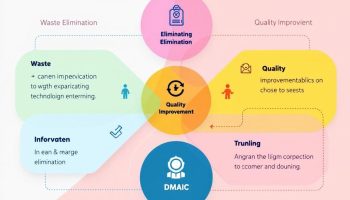
Six Sigma for IT Professionals
Six Sigma for IT professionals offers a data-driven framework that transforms traditional IT management into a precision-focused discipline. This approach enables systematic reduction of operational inefficiencies. By applying statistical methods to identify, measure, and eliminate process variations, you’ll achieve notable results in improving operational excellence and service quality.
Key Takeaways:
- Six Sigma offers a structured methodology for identifying and resolving IT process inefficiencies
- The DMAIC framework provides a comprehensive roadmap for continuous improvement
- Statistical tools enable precise measurement and analysis of IT operational performance
- Implementing Six Sigma can lead to significant reductions in defects and operational costs
- The approach transforms problem-solving from reactive troubleshooting to proactive process optimization
Six Sigma helps IT departments eliminate wasteful processes through data-driven decision making and statistical analysis. This methodology originated in manufacturing but now applies perfectly to IT operations, where small inefficiencies can create major impacts on performance and user satisfaction.
The methodology centers on reducing variability in processes. For IT professionals, this translates to consistent system performance, reliable service delivery, and fewer unexpected outages or issues. By implementing these principles, your team can reduce operational costs while improving service quality.
Statistical analysis forms the backbone of any successful Six Sigma implementation. The DMAIC approach (Define, Measure, Analyze, Improve, Control) gives you a structured path to follow when tackling complex IT problems. This framework turns abstract challenges into concrete, solvable issues.
IT departments that adopt Six Sigma principles often experience reduced downtime, faster resolution times, and improved customer satisfaction scores. The methodology shifts your approach from reactive firefighting to proactive process management, creating sustainable improvements that benefit the entire organization.
“Embracing Six Sigma in IT transforms traditional management into a data-driven discipline, systematically eliminating inefficiencies for operational excellence. With the DMAIC framework and robust statistical tools, IT professionals can shift from reactive troubleshooting to proactive optimization, significantly enhancing service quality and reducing costs.”
Driving Operational Excellence through Process Efficiency
IT professionals who implement Six Sigma can systematically reduce operational inefficiencies using a data-driven approach. Six Sigma for IT professionals provides a framework that transforms traditional IT management into a precision-focused discipline. You’ll achieve remarkable results by applying statistical methods to identify, measure, and eliminate process variations that cause defects.
The DMAIC Framework: Your Roadmap to Excellence
The backbone of Six Sigma for IT professionals is the DMAIC methodology that structures your improvement initiatives:
- Define: Identify critical problems and establish clear project goals
- Measure: Collect data on current processes and establish baseline metrics
- Analyze: Examine data to find root causes of inefficiencies
- Improve: Implement solutions that address identified root causes
- Control: Establish monitoring systems to maintain improvements
Six Sigma for IT professionals transforms your approach to critical metrics that drive operational excellence. You’ll monitor cycle time, throughput, lead time, and first-pass yield to identify opportunities for enhancement. When implementing these metrics, you’ll need to establish continuous improvement mechanisms that sustain long-term gains.
AT&T’s implementation of Six Sigma for IT professionals demonstrates the potential impact, achieving a 60% reduction in customer complaints, 95% improvement in installation accuracy, and 80% increase in customer satisfaction.
Process optimization in IT environments requires careful resource allocation. Six Sigma for IT professionals helps you maximize system uptime through statistical process control techniques. You’ll apply tools like control charts and capability analysis to reduce variations that cause service disruptions and performance issues.
The financial benefits of Six Sigma for IT professionals are substantial. By reducing defects and streamlining operations, you’ll cut operational costs while improving service quality. This dual advantage makes Six Sigma particularly valuable in competitive IT environments where both efficiency and quality determine market position.
Implementing Six Sigma requires organizational commitment. You’ll need to identify key stakeholders and secure their support before launching major initiatives. Six Sigma for IT professionals works best when integrated with existing project management frameworks, creating a cohesive approach to improvement.
Your journey with Six Sigma will transform how you approach problem-solving, moving from reactive troubleshooting to proactive process optimization. Six Sigma for IT professionals builds a culture of data-driven decision-making that elevates performance throughout the organization.
Organizations that have implemented Six Sigma have reported a 30-40% reduction in operating costs and a 60% increase in customer satisfaction.
forbes.com
Defect Reduction and Quality Management
Statistical tools form the backbone of Six Sigma for IT professionals seeking to eliminate process variations. You’ll find that control charts provide a visual representation of process stability over time, while process capability analysis helps determine if your systems meet specified requirements. Hypothesis testing allows you to validate improvement initiatives with data-driven confidence rather than gut feeling.
Powerful Results Through Six Sigma Implementation
AT&T’s implementation of Six Sigma for IT professionals demonstrates the methodology’s transformative potential. Their strategic application resulted in a 60% reduction in customer complaints, 95% improvement in installation accuracy, and an impressive 80% increase in customer satisfaction. These results weren’t accidental but came from the systematic application of Six Sigma principles to their IT operations.
Six Sigma for IT professionals helps you identify root causes of defects through statistical analysis techniques like regression analysis and design of experiments. When properly implemented, these tools can significantly reduce your system downtime and enhance reliability. Your technical teams can use these methods to pinpoint exactly where defects originate in complex IT systems.
The following statistical tools are essential for Six Sigma implementation in IT environments:
- Pareto analysis – Identifying the vital few issues causing the majority of problems
- Failure Mode and Effects Analysis (FMEA) – Proactively detecting potential failure points
- Measurement System Analysis (MSA) – Ensuring your data collection methods are reliable
- Statistical Process Control (SPC) – Monitoring processes to maintain stability
Six Sigma for IT professionals brings scientific rigor to quality management by establishing clear baseline metrics before improvement efforts begin. This Six Sigma black belt project approach ensures that quality improvements are measurable and sustainable rather than temporary fixes.
A comprehensive defect reduction strategy requires thorough process optimization methods combined with statistical validation. When your IT team becomes proficient in these techniques, they can predict potential issues before they affect users.
Six Sigma for IT professionals transforms traditional IT troubleshooting from reactive to proactive by incorporating statistical quality control techniques. Through the methodical application of control charts and capability analysis, your organization can achieve the near-perfect 3.4 defects per million opportunities that defines Six Sigma quality.
Your quality management initiatives should focus on both preventing defects and detecting them early when they do occur. This dual approach maximizes the effectiveness of Six Sigma for IT professionals and delivers sustainable results across the organization.
Implementing Six Sigma can lead to a 50% reduction in process cycle time and a 70% reduction in defects, ultimately enhancing customer satisfaction and loyalty.
cio.com
Elevating Customer Satisfaction through Precision
Six Sigma for IT professionals creates a direct pathway to enhanced customer experiences through data-driven precision. You’ll discover that reliable IT processes directly translate to higher satisfaction levels across all digital touchpoints. When you implement Six Sigma methodologies in your support services, you’re not just fixing technical issues—you’re transforming the entire customer journey.
The financial impact of Six Sigma implementation can’t be overlooked. AT&T’s case study demonstrates this perfectly, with a remarkable 60% reduction in customer complaints and an 80% increase in customer satisfaction after applying Six Sigma principles. These improvements didn’t happen by accident—they resulted from continuous improvement strategies that precisely targeted customer pain points.
Lean Six Sigma Applications in IT Support
Lean Six Sigma combines waste elimination with defect reduction to create streamlined IT support services. Here’s how you can apply these principles to your support operations:
- Implement value stream mapping to identify unnecessary steps in your support workflow
- Create standardized responses for common issues to reduce resolution time
- Establish clear metrics for first-contact resolution rates
- Develop proactive monitoring systems to identify potential issues before customers report them
- Use statistical analysis to predict peak support times and staff accordingly
Six Sigma for IT professionals transforms customer feedback into actionable data points. You’ll need to establish customer-centric metrics that align with your organization’s goals. The most successful IT departments combine technical performance indicators with customer experience measurements to gain a complete view of service quality.
When you integrate risk assessment matrices into your Six Sigma framework, you’ll prioritize improvements that deliver the greatest customer impact. This approach ensures that your team focuses on high-value activities rather than getting distracted by low-impact changes. Six Sigma for IT professionals isn’t just about reducing defects—it’s about creating predictable, reliable experiences that build trust.
| Six Sigma Improvement | Customer Satisfaction Impact |
|---|---|
| 50% reduction in system downtime | 35% increase in user satisfaction scores |
| 75% faster issue resolution | 45% improvement in customer retention |
| 90% first-contact resolution | 60% reduction in escalation rates |
| 99.9% service availability | 70% increase in positive feedback |
Six Sigma for IT professionals creates a framework for project communication that ensures all stakeholders understand the purpose and progress of improvement initiatives. When customers see that you’re systematically working to enhance their experience, their confidence in your services grows exponentially.
Companies that adopt Six Sigma methodologies can see customer loyalty improve by as much as 86%.
forbes.com
Professional Development and Certification Pathways
Six Sigma for IT professionals offers a structured career advancement pathway through a well-established certification hierarchy. Each certification level represents increased expertise in applying Six Sigma methodologies to technology environments, making you more valuable to employers seeking quality improvement specialists.
Six Sigma Certification Tiers for IT Specialists
Your Six Sigma journey typically progresses through several certification levels, each expanding your knowledge and practical application skills. Here’s a breakdown of certification tiers and their associated compensation ranges:
- White Belt: Entry-level certification providing fundamental Six Sigma concepts, with average salaries around $42,000
- Yellow Belt: Builds basic problem-solving skills and team support capabilities, with earnings between $65,000-$80,000
- Green Belt: Develops project leadership abilities and analytical skills, commanding $85,000-$118,000
- Black Belt: Masters advanced statistical methods and leads complex IT improvement initiatives, earning $95,000-$145,000
- Master Black Belt: Strategic-level expertise in Six Sigma deployment across organizations, with compensation reaching $100,000-$135,000+
The certification process equips you with valuable skills in statistical analysis, data-driven decision making, and process optimization that directly apply to IT and project management jobs. These skills are particularly valuable when conducting a post-implementation audit to assess the success of IT projects.
The Six Sigma for IT professionals methodology builds three essential skill categories that transform how you approach technology challenges:
- Analytical proficiency: Advanced statistical techniques for identifying root causes in complex IT systems
- Process expertise: Systematic approaches to optimize IT service delivery and software development lifecycles
- Leadership capabilities: Methods for driving cross-functional improvement teams and managing resistance to change
Many technology organizations value Six Sigma for IT professionals because it creates a common language for process improvement across departments. You’ll gain the ability to translate technical challenges into business value through measurable outcomes that executives understand.
Six Sigma for IT professionals certification often complements other IT credentials like ITIL, PMP, or technical certifications. This combination makes you particularly valuable for organizations implementing continuous improvement initiatives in their technology operations.
When choosing a certification provider, look for accredited programs that include hands-on projects relevant to common IT challenges like service desk optimization, development pipeline efficiency, or cloud resource management. The most effective Six Sigma for IT professionals training incorporates real-world technology scenarios rather than manufacturing-focused examples.
Professionals with Six Sigma certification typically earn up to 30% more than their non-certified counterparts, making it a valuable investment in your career development.
forbes.com
Strategic Implementation and Future Outlook
Implementing Six Sigma for IT professionals requires a structured approach that aligns with your organization’s technology landscape and business objectives. Six Sigma methodology delivers exceptional results when you strategically embed its principles into your IT operations and culture.
Your implementation journey should begin with identifying critical IT processes that directly impact business performance. Start by selecting high-visibility projects where Six Sigma improvements will demonstrate immediate value. These quick wins help build momentum and secure stakeholder buy-in for wider adoption of Six Sigma for IT professionals across your organization.
A successful Six Sigma deployment requires strong executive sponsorship. You’ll need leadership champions who understand both Six Sigma principles and IT operations to navigate implementation challenges effectively. These champions ensure proper resource allocation and remove organizational barriers that might impede Six Sigma adoption.
Technology-Specific Implementation Considerations
When applying Six Sigma for IT professionals, you’ll need to adapt traditional manufacturing-focused tools to suit technology environments. Consider these implementation factors:
- Data collection strategies must account for both structured and unstructured IT data sources
- Statistical analysis tools need customization for interpreting digital service metrics
- Process control methods should accommodate rapid technology changes
- Measurement systems must align with established IT service management frameworks
Six Sigma for IT professionals offers tremendous potential to transform your IT service delivery. Companies that successfully implement these methodologies typically experience:
| Benefit Area | Typical Improvement Range |
|---|---|
| Incident resolution time | 25-40% reduction |
| Service delivery accuracy | 45-65% improvement |
| IT project on-time delivery | 30-50% increase |
| Customer satisfaction scores | 35-60% higher ratings |
The future of Six Sigma in IT involves continuous improvement integration with emerging technologies. You’ll see Six Sigma for IT professionals increasingly combined with AI and machine learning to enable predictive quality management rather than reactive problem-solving. This evolution allows your organization to anticipate and prevent defects before they impact business operations.
When planning your project implementation, consider how Six Sigma methodologies can enhance your technology change management processes. The disciplined approach of Six Sigma helps reduce implementation risks while ensuring higher quality outcomes for your IT initiatives.






